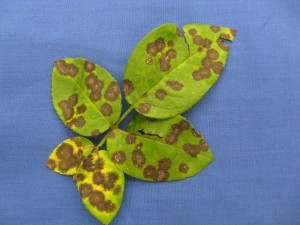Rose Blackspot- Diplocarpon rosae
 Roses are among the most beautiful flowers in the home landscape or garden. Blackspot is one of the most common and serious fungal diseases on rose plantings throughout Kansas. Dark-brown to black leaf spots develop on the upper leaf surface about mid-to-late May. The leaf spot lesions are roughly circular and have distinctive, irregular, feathery margins. The spots range in size from 1/16 to 1/2 inch in diameter. Individual leaves may develop multiple leaf spots. At the beginning of the growing season, the blackspot will develop on the lower leaves and move upward through the plant as the season progresses. Infected foliage eventually turns yellow and falls off the plant. Heavy infections can seriously defoliate a plant.
Roses are among the most beautiful flowers in the home landscape or garden. Blackspot is one of the most common and serious fungal diseases on rose plantings throughout Kansas. Dark-brown to black leaf spots develop on the upper leaf surface about mid-to-late May. The leaf spot lesions are roughly circular and have distinctive, irregular, feathery margins. The spots range in size from 1/16 to 1/2 inch in diameter. Individual leaves may develop multiple leaf spots. At the beginning of the growing season, the blackspot will develop on the lower leaves and move upward through the plant as the season progresses. Infected foliage eventually turns yellow and falls off the plant. Heavy infections can seriously defoliate a plant.
The black spot fungus can also develop on one-year-old canes. Infected canes develop raised, purplish-red spots or blotches, which eventually blacken and appear blistered. Cane lesions rarely kill affected branches; however, they can act as an important overwintering site for the fungus. Blackspot development is favored by warm (75°F), wet weather. This means the disease is primarily active in late spring or early fall and whenever warm, wet weather occurs. Blackspot primarily overwinters on infected leaf litter beneath the rose bushes. In the spring, fungal spores are windblown or splashed onto newly emerging leaves on the lower portion
of the plant. As the season progresses, spores from newly infected foliage are splashed or blown upward to infect more leaves. The spores are only spread in water droplets. The fungus has not been found to survive in the soil.
Blackspot disease control should start with the selection of an appropriate planting site and the use
of resistant cultivars, if possible. Roses should be planted in an area with plenty of sunlight and good air movement. Good air circulation will reduce the time moisture remains on the foliage. This is important, as blackspot infection can occur after just seven hours of continuous leaf wetness. Avoiding dense plantings, not wetting the foliage in the evening, and not misting or hosing down the plants if doing so will increase the hours of wetness beyond seven hours and help reduce conditions favoring infection. Fall leaf debris should be raked up and discarded. Removing leaf litter combined with pruning out diseased canes will help reduce overwintering blackspot fungi. Diseased plant material should not be composted. Unless the composting process completely breaks down the plant material, it may be redistributed into the landscape setting.
Few cultivars are resistant to black spots when selecting plant material for a rose planting. The occurrence of different pathogenic races makes it challenging to develop roses that are resistant to black spots. Rose groups susceptible to blackspot include teas, hybrid teas, hybrid perpetuals, Pernetianas, Austrian briers, and polyanthas. Roses that show some resistance include Rugosa hybrids, moss roses, and Wichurianas.
Control measures for susceptible roses should include fungicide applications throughout the growing season. Starting at the first sign of disease, fungicide applications should be made at 7- to 14-day intervals depending on the weather. Many fungicides are effective against black spot, including copper fungicide, chlorothalonil, myclobutanil, neem oil, propiconazole, sulfur, tebuconazole, triticonazole, and triophanate methyl. The most effective disease control strategy will include a combination of cultural practices, sanitation measures, and fungicide treatments.

Have questions? Contact our office where our Horticulture Extension Agent will assist you with questions.
Phone: (316) 321-9660
Email: callae@ksu.edu